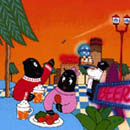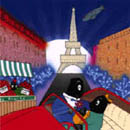![]()
![]()
|
Let's take a look at how neon signs have developed while changing from neon to electric signs. |
 |
The Paris International Expositions during the early years of the 20th century Neon signs were perfected by the French scientist George Claude, and were presented to the public for the first time at the Paris International Exposition held at the start of the 20th century. About two decades later, in 1926, the first neon signs created in Japan were turned on to become public at Hibiya Park in Tokyo. It was about three-quarters of a century before today. Until then colored light bulbs had been the most prevailing device for illuminations, but the popularization of neon signs brought about a revolution in light source for outdoor advertising, from gpointh to glineh and gplaneh. |
1964: The Tokyo Olympics Neon signs have gone hand in hand with Japanese postwar economic development. The Tokyo Olympics was an event, which came to be regarded as a symbol of high-level economic growth in Japan. After they were held in 1964, there was an enormous increase in demand for outdoor advertising, and technical innovation occurred in many related fields. This is an easy enough phenomenon to observe: the visual images showing economic development at that time are invariably accompanied by pictures of urban scenes full of neon signs. The neon sign had become the symbol of peace and economic development. |
 |